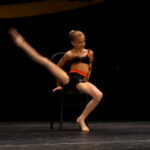Slam Dancing, often known as “moshing,” is a high-energy and sometimes chaotic dance style deeply embedded in the culture of punk rock, ska, and metal music. Emerging in the 1970s and 1980s alongside these genres, slam dancing is more than just random movements; it’s a physical expression of music that can be both exhilarating and risky.
While some might hesitate to even call it “dancing” in the traditional sense, slam dancing involves vigorous jumping and energetic body movements within a crowd, typically at live music events. Participants often engage in actions that might appear unstructured, like throwing kicks and punches in the air, and moving their bodies with intense, almost frenetic energy. Despite its seemingly unrefined appearance, for many, slam dancing serves as a powerful emotional and physical release.
More commonly referred to as “moshing,” this dance style thrives in the atmosphere of high-energy concerts across various music genres, not just limited to its punk rock origins. Moshing typically involves crowds bouncing, pushing against each other, and even participating in “crowd surfing,” where individuals are lifted and passed overhead by the audience. This high-contact nature is a defining characteristic of moshing, contributing to both its excitement and potential hazards.
The intention behind slam dancing is debated. Many early participants argue that it was conceived as a non-violent way to release energy and connect with the music. However, the reality of slam dancing is that it can, at times, become violent. The risk of injury escalates when factors like intoxication or aggression come into play, turning a communal dance into a potentially dangerous situation for everyone nearby.
Tragically, there have been numerous incidents highlighting the dangers of mosh pits, some with severe consequences. A stark example is the 1996 Smashing Pumpkins concert in Dublin, Ireland, where a young fan tragically died after being crushed in a mosh pit. Such events have led many artists to speak out against moshing, urging concertgoers to prioritize safety and refrain from this form of dance due to its inherent risks.
Despite the controversies and dangers, slam dancing remains a significant aspect of live music culture for many bands and fans. It is seen by some as a unique form of crowd engagement and a powerful outlet for self-expression within the music community.
If you are attending a concert where slam dancing is likely, it’s crucial to be aware of what to expect and to be prepared. If you choose to participate, engage fully and be mindful of those around you. If you prefer to avoid it, it’s best to stay towards the edges of the crowd or areas away from the mosh pit to avoid being inadvertently caught up in the pushing, shoving, and unpredictable movements of slam dancing.

